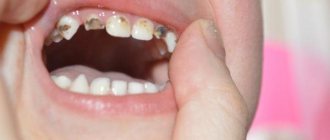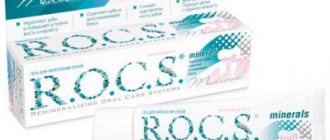Good day, dear readers. If you have young children, then most likely you have heard about different dental procedures for them. Many parents who complain about the poor condition of their children’s teeth can be offered options for solving this problem. Among them is such a popular technique as silvering teeth.
Silvering of baby teeth
As is known, the chemical element silver (Ag) has antibacterial properties, and the main cause of tooth decay, caries, is caused precisely by their activity. Of course, there are other reasons, including demineralization, which we will also look at as we study this topic.
Silvering and fluoridation of baby teeth
Why are teeth silvered in childhood?
Very often in order for frightened mothers to calm down at least for a while. The fear that a child's teeth will deteriorate/fall out prematurely haunts many young parents. After all, this is quite real and they see examples of similar situations among the children of their neighbors, acquaintances, and relatives.
Silvering of teeth in children
If we talk about a medical point of view, it is believed that silvering baby teeth helps in the prevention of caries and even stops its development in the initial stages. As practice shows, this technique often turns out to be quite effective.
What is silvering of teeth
Did you notice that I wrote “often”? The fact is that there are no two identical children who would be affected 100% equally by any method/drug used in medical practice. Pardon the tautology, but I can’t describe this simple fact any other way.
When silvering occurs, tooth enamel becomes noticeably darker. Therefore, this method is used for baby teeth, which will eventually fall out anyway.
Silvering teeth for children
For permanent teeth, this method of prevention is pointless. After all, the surface of the treated tooth does not look aesthetically pleasing at all.
Having discovered obvious signs of caries in their baby, parents run to the children's dental clinic or to private doctors with a request to stop the destructive process. It is very important that the child does not lose his baby teeth. This is where the pediatric dentist needs to decide whether to fill the tooth or silver plate it. For the front incisors, a filling is not the best option. She is holding up extremely poorly. The professionalism of the dentist plays a very important role. He should not choose a technique according to the principle “the more expensive, the better.”
Children's teeth after silvering procedure
Indications and contraindications
The decision on the advisability of using a silver solution is made by the doctor. Indications for the procedure are:
- Carious spots in the initial stage of the disease.
- Microcracks and chips on the tooth surface.
- Sensitivity and obvious anxiety of the child, making it impossible to use the drill.
- For children living in areas with low levels of fluoride in water and food, teeth silvering may be prescribed as a preventative measure.
In some cases, the method is used to increase the service life of the filling.
If parents are in doubt whether or not to silver their baby’s teeth, they need to take into account contraindications, which are:
- Large degree of tooth damage: caries in the middle and deep stages.
- Living in an area characterized by high fluoride content.
Causes
Why does the problem itself arise? It varies from person to person, but most often it’s due to diet and poor oral hygiene. For example, you give sweet juices and lemonades, especially at night. The result is obvious - caries. Does your child eat sweets and cakes? Sugars and carbohydrates are excellent “food” for bacteria that destroy his teeth.
What you can and cannot feed your baby at night
If the diet lacks calcium, vitamin D and other substances valuable for teeth, this can also cause destruction of enamel and other tissues.
- Silvering of baby teeth
Caries of baby teeth
Sometimes babies can have congenital enamel defects. In these cases, silvering is used to prevent future problems. But don’t be lazy to ask what else you need to do to protect fragile teeth.
Causes of caries in baby teeth
Protection of baby teeth in modern dentistry
In addition to silvering and fluoridation of baby teeth, modern science offers:
- traditional dentistry treatment with boron, using modern drills, painless and effective if the right approach is found by the doctor to the baby;
- the use of remineralization - the use of toothpastes containing minerals necessary to strengthen teeth - calcium, fluorine, phosphorus, of which there are many types on the market now;
- ozonation – treatment of milk tooth tissues, including root canals, with ozone. It is similar to silvering, stops the development of microbes and caries;
- sealing the fissures of the tooth - the recesses in the tooth are filled with a special sealant, which allows you to seal them, protect them from further destruction, and deliver to the tooth tissues the mineral ions necessary to strengthen it. This is a treatment method and a preventive measure at the same time.
- Prosthetics after the removal of a baby tooth are used to form a correct bite.
Remineralization of baby teeth involves coating the tooth enamel with special compounds. One of the methods that dentists use to protect teeth is coating with artificial enamel, which creates a certain barrier protection for the teeth.
Each of the above methods is effective in its own way. The choice is up to the baby’s parents based on the advice of the attending physician, depending on the condition of the baby teeth and the health of the child.
How is the teeth silvering procedure performed?
The doctor uses silver nitrate AgNO₃. Of course, not in its pure form, but in the form of a 30% solution. There are also more modern preparations that combine fluoride and silver. They have a pronounced effect in the fight against carious bacteria.
Silvering process
How it works? The drug forms a film of solid insoluble salts on tooth enamel, which not only defeat bacteria, but also prevent the destruction of the enamel even if there are spots on it (demineralization or the initial stage of caries).
The drug is applied for a few minutes, so it does not cause any discomfort. Complete painlessness is guaranteed during the use of the active ingredients.
Silvering of baby teeth
Video - Treatment of caries of temporary teeth using silver impregnation method
Indications
You cannot silver permanent teeth - only baby teeth. The method is justified in the following forms of caries found on the front teeth:
- surface;
- medium (assuming the cavity is shallow and the patient will carefully care for the treated units);
- planar (I mean a defect in which the entire crown or several adjacent teeth are affected);
- circular (dental neck is affected).
It is also recommended to carry out the procedure if the child’s enamel is insufficiently mineralized.
It is not advisable to use silver when working with molars. If they already have holes, only filling will help. This is due to the fact that food particles will constantly accumulate in the chewing teeth, which means that the destructive process will continue.
How often do you need to silver your teeth?
According to pediatric dentists, the most effective effects of drugs containing silver are as follows:
- repeat silvering of teeth 3 or 5 times;
- this can be done in a row or every other day;
- It is optimal to do this every 4 months. If this is not possible - twice a year.
Silvering teeth in children has a positive effect in terms of protecting not only hard tissues (enamel), but also soft tissues (dentin). The frequency of repetition of procedures is individual for children of different ages. It also depends on how well oral hygiene is implemented and whether the child is fed naturally.
Boy with silvered teeth, teeth after silvering
Advantages of the method
In addition to the absence of pain, silvering teeth in children has many more advantages:
- Treatment is carried out with an inexpensive drug and in a short time, which reduces the cost of the procedure.
- The solution is safe for children's bodies and is suitable even for infants.
- Preserves the development of caries.
- There is no risk of injuring the baby and creating a fear of treatment at the dentist.
Painlessness during the procedure is one of the main advantages of the method. The drug is applied without the use of dental instruments, using a soft applicator. This is very convenient for children 2–3 years old; it is at this age that caries first makes itself known.
Silvering of teeth - expert opinions on the technique
There are many different opinions among dentists. They constantly argue, arguing for and against silvering teeth, citing research.
Fact one - silver nitrate, if it penetrates deep into the tooth tissue, can damage the pulp.
One-component argenate - material for use in the initial forms of development of carious processes (liquid 5 ml)
What do doctors suggest? Nowadays, there are a lot of combination drugs that are effective, but safer.
Fact two - combination drugs contain fluorides, which, according to some scientists, can be harmful.
Benefits of silvering teeth
Dentists have differing opinions. Some say that the dose of this halogen is insignificant and cannot harm a person. Others argue that even microdoses that exceed the body's actual needs are a health threat.
- Silvering of teeth in children
- If caries has affected the chewing teeth, the procedure is unlikely to be beneficial.
- With advanced caries, there is also no guarantee that silver nitrate will be able to stop the process.
- Do not forget that the surface of the enamel will be covered with a brown or even black film.
Silvering of baby teeth “Pros” and “Cons”:
| Positive facts | Negative arguments |
| By silvering baby teeth in children, the procedure of drilling with a drill and further filling can be postponed until the future. Carious destruction is stopped | This procedure is not effective on the chewing part of the teeth and prevents the detection of caries. |
| The film formed on the surface layer of enamel after silvering protects against plaque and the proliferation of pathogenic bacteria | Silver teeth, when exposed to light, take on a dark tint. |
| The silvering procedure is simple and painless, and does not cause discomfort to the child. | In the stage of advanced caries, silver treatment is ineffective and can cause harm |
| The silvering workflow will not take much time. Small children can easily withstand and tolerate this procedure. | Thoroughly cleaning a child's teeth is an extremely difficult task. And before silvering, this action is necessary |
| Lowest price | To achieve the effect, you need to repeat the procedure more than once a year. |
Therefore, before going to the doctor, think about whether it is worth silvering your teeth or using another technique. As long as there is a small white spot on the tooth, it is not at all necessary to resort to radical measures. It may make sense to start the demineralization procedure. There are special products applied to the enamel for this purpose. You also need to make sure that the child brushes his teeth and eats properly.
Silvering of teeth in children
In the USA and most European countries, this technique is no longer used, being considered outdated. In the CIS, there are still few worthy alternatives that would be sufficiently effective and would not have side effects.
Do not forget that before applying silver preparations, soft and hard deposits must be completely removed from the teeth. When a three-year-old child sits in a dental chair, this is very problematic. He will spin around, avoiding what he considers “scary” medical instruments.
You cannot apply Saforite, Argenate or other products to unbrushed teeth. These two drugs are silver fluoride diamine - combination drugs that are considered the most modern and safe.
"Argenat"
It's important to know that. Unlike fluoridation, silvering teeth yourself at home is contraindicated. Considering that this procedure is not the most expensive, there is no point in violating the instructions of experts and self-medicating.
Content:
- Indications
- Optimal age for treatment
- How Reconstituted Silver Works
- How children's teeth are silvered
- Advantages of the technique
- Disadvantages of the technique
Doctors silver baby teeth to prevent tooth decay and prevent existing cavities from spreading further.
The technique is usually used when working with two- and three-year-old patients. It is recommended for older children if they have a very strong fear of the dentist. How effective the silvering procedure will be largely depends on the stage of the dental disease. The best results can be achieved by treating white spots on enamel with silver, as well as with superficial (shallow) carious cavities.
It is acceptable to treat teeth immediately after they erupt, for example, when the baby is six months old. The coating session is absolutely painless and therefore does not require the administration of an anesthetic.
Attention! If the baby is not prone to caries and his teeth are in satisfactory condition, silvering is simply not worth it. After it, the enamel acquires an unsightly dark gray or black color, which can cause psychological complexes in the child when he begins to pay attention to his appearance. Only if there are medical indications should you call for help with a silver solution.
Other dental protection options
Most often, if there are no holes or significant damage on the tooth, experts may recommend fluoridation - regular or deep. Special pastes and other means are also selected to help stop the process of enamel destruction.
Fluoridation of teeth
The use of sodium fluoride is a popular alternative to silver plating, but this method is not a panacea. In addition, if your region has fluoridated water or there is a company whose activities are somehow related to fluoride emissions, the use of such techniques may even be dangerous. After all, poisoning with fluoride compounds causes fluorosis and other diseases.
In addition, fluoridation can only be done after 2 years, when the enamel is formed and strong enough. Otherwise, fluoride will cause a reverse reaction - softening of tooth tissue, which will accelerate their destruction.
Fluoridation of teeth in children
When choosing a technique, much depends on the professionalism of the doctor. His task is to determine which method will be relevant for each specific patient.
- Silvering of teeth in children
Video - Other options for protecting teeth
What are the alternatives to teeth silvering?
The choice of alternatives is not great. This is either remineralization or deep fluoridation.
1) Treatment of caries with the drug “ICON” –
This technique is effective only in the presence of caries at the white spot stage, i.e. when on the surface of the enamel there are only foci of demineralization (without the formation of actual carious defects). The drug "ICON" is a composite material that is designed to seal pores in tooth enamel. After treating teeth with this drug, the white spots disappear, and as a result of treatment, the diseased tooth is almost impossible to distinguish externally from healthy ones.
Thus, we have the following advantages - 1) the procedure does not require anesthesia, 2) there is no terrible dark color of the teeth as after silvering, 3) the procedure is guaranteed to stop the development of caries. However, it should be noted that this method can only be used in children, usually only from 3 years of age (due to the fact that the child will have to sit in a chair for about 15-20 minutes). In addition, this method has a higher cost compared to teeth silvering.
2) Remineralizing therapy –
The remineralization technique allows us to saturate weakened areas of enamel with minerals (primarily calcium and phosphates). This method is used in the treatment of caries in the white spot stage, as well as superficial caries. But this method will be effective only if oral hygiene is normalized, as well as the consumption of easily digestible carbohydrates between main meals, including sweet and sour juices, and sweet soda.
There are not many drugs for enamel remineralization. One of the most effective preparations is the GC Tooth Mousse gel; you can also use Russian gel (based on calcium glycerophosphate and xylitol). Both drugs are convenient to use at home, and are available when ordering online. Gel “GC Tooth Mousse” is more effective, and it is most often used by dentists for professional remineralization.
Example of drugs for remineralization of teeth -
During the course of remineralization, it is very important to use toothpastes without fluoride for oral hygiene. However, after completing the course of treatment, on the contrary, it is very important to start using toothpaste with fluorides (either sodium fluoride or amino fluoride), because in this case, fluoride will allow calcium to be fixed in the tooth enamel. Using the link below, you can choose such a paste for your child, taking into account safe dosages of fluoride at different ages. For example, safe dosages of fluoride for children 1-3 years old range from 250 to 500 ppm (provided the concentration of fluoride in drinking water is not exceeded).
→ How to choose children's toothpaste with fluoride
3) Deep fluoridation of teeth –
The purpose of deep fluoridation is to saturate weakened areas of enamel with fluoride in order to reduce the leaching of calcium from tooth enamel, as well as to increase the hardness of tooth enamel. It is noted that deep fluoridation is effective not only for white chalky spots, but also for superficial caries. The effectiveness of fluoridation largely depends on the dosage of fluoride in the drug, and therefore professional fluoridation by a dentist will be more effective.
Indications for the use of deep fluoridation – 1) initial caries in the stage of a white chalky spot, 2) superficial caries, i.e. within the limits of the thickness of the enamel, 3) prevention of the appearance of new foci of caries. Fluoridation should definitely be carried out only at a dentist’s appointment, because the concentrations of professional fluoridation products are very high (up to 20,000 ppm), and the use of such drugs can only be carried out by a dentist. So what drugs are there for fluoridation...
One of the best drugs is “Enamel-sealing liquid Tiefenfluorid” (Germany). This drug is two-component: first, a suspension with active calcium is applied to the teeth, and only after a few minutes a fluoride solution is applied. Thus, this drug combines both remineralization and deep fluoridation. There is also a large selection of special dental varnishes containing fluorides (fluoride varnishes), which are applied to the enamel of teeth in the dentist's office. You can find an example of effective varnishes for fluoridating teeth in the article at the link below.
→ Preparations for fluoridation of teeth
Silvering of teeth - what do parents write?
Having studied numerous reviews about teeth silvering written by mothers of babies, I came to the conclusion that doctors often prescribe this procedure simply for the sake of money. That is, they do this, fully aware of the fact that this will not help the child.
Child at the dentist
Not everyone wants their child to walk around with black teeth. Adults don’t care, but other kids will tease you. They don’t understand what this treatment is. Therefore, many mothers and fathers do not take risks, realizing that their teeth will not completely change tomorrow or even in a month. If a child goes to kindergarten and is the only one there with such teeth, expect to come home in tears.
The second point is the hereditary factor. It, like various situations during pregnancy, can affect the destruction of baby teeth no less than caries. No amount of silver will help you here. Many parents and dentists are faced with this problem, either they shrug their shoulders or use fluoride and silver on the principle of “what if it helps.”
Silvering does not always help
The third point is stress. Of course, silvering your teeth doesn’t hurt. Only now, if you are bringing a baby to the doctors who is barely one and a half years old, he will be very nervous.
There are also those parents who are delighted. They had the procedure done on time and, apart from black teeth, there were no negative consequences. The caries stopped, which means the method helped them. There are as many such reviews as those that talk about the uselessness of using this method.
Many children suffer from mineral imbalances. Without understanding it properly, dentists prescribe silver plating. Of course, there is practically no benefit from such work. After all, the problem is “internal” and has nothing to do with caries. Therefore, the destruction continues. To help a child in such circumstances, you need a competent, and most importantly, comprehensive approach, including:
- diet correction;
- prescription of vitamin and mineral complexes;
- external use of pastes and other means of demineralization of enamel;
Girl at the dentist
The most interesting thing is to read how, under pressure from worried parents, permanent teeth are silvered for seven-year-old children. This is nonsense and should not be done under any circumstances. Especially when it comes to caries of permanent teeth. They will not change and will remain black forever! It will be very difficult for the child when he grows up. What to do next? Should I get crowns or veneers after 18 years of age? Don't create additional problems for your children in the future.
Oral hygiene is very important
You can also advise trivial but important things - no matter how capricious children are or struggle, you should brush their teeth twice a day. Choose a good brush and toothpaste. When they grow up, they will thank you for healthy teeth. Do not give them sweets at night, do not feed them, do not give them juices. All these typical mistakes of parents always end equally badly.
Why is it important to save every baby tooth?
- To protect permanent teeth.
Advanced caries can not only lead to the destruction of milk teeth, but also damage the rudiments of permanent ones. - To form the correct bite.
Early removal of baby teeth will lead to displacement of the dentition, and the permanent bite will be incorrect. - For the health of body systems.
Long-term absence of teeth can lead to disruption of the digestive system, as the child will not be able to chew food well.
Advantages and disadvantages
Silvering of teeth is a universal procedure, which is characterized by both pros and cons. The undeniable advantages include the following aspects:
- silvering of teeth is a simple procedure that is carried out in the shortest possible time and is characterized by the absence of pain and discomfort;
- To carry out the manipulation, environmentally friendly material is used, which does not include toxins, highly allergenic components and impurities, which ensures the safety of the manipulation and allows it to be carried out for all small patients;
- the cost of the procedure is quite low, which guarantees its accessibility for most parents;
- After the manipulation, there is no need to take your child for monthly dental checkups, which is explained by the long-term effect of the procedure;
- After silvering, teeth become more durable, which eliminates the possibility of premature damage to the enamel and their destruction;
- On silver-plated milk teeth, chips and cracks appear in extremely rare cases;
- The manipulation is recommended in the treatment of caries, which allows you to prevent this disease before the physiological change of permanent teeth.
Despite the large number of advantages, silvering manipulation also has a number of disadvantages:
- After a certain time, destruction of the silver layer is observed under the influence of acidic foods - juices, fruits, vegetables, and that is why there is a need to periodically repeat the manipulation.
- In chewing areas, the use of this method is not advisable (this is due to the lack of the desired effect).
- In addition, after silvering, it is difficult for the dentist to detect damaged areas.
- After the procedure, baby teeth have an unsightly dark color; this negatively affects the child’s psychological health, as he is often embarrassed to smile.
- The material used belongs to the category of aggressive substances, which, if it comes into contact with the mucous membrane, can cause redness and itching.
- Some patients were diagnosed with oral tissue burns.
- We noted an unpleasant taste of the composition.
- If a young patient has an advanced stage of the disease, then the use of the technique is strictly prohibited.
So, the positive and negative aspects of the silvering procedure have been identified. The dentist can decide whether manipulation is necessary only after assessing the condition of the oral cavity.
How to lighten teeth after silvering?
Unfortunately, the dark color resulting from the silvering procedure cannot be removed. The treating dentist should warn every parent who decides to take such a step about this. It is worth first assessing and comparing the benefits acquired with possible side effects!
If you do the procedure less often than the specified period, the blackness gradually fades, but does not go away completely . It is necessary to remember that any procedures associated with chemical bleaching are contraindicated for young children. If the color of your baby's teeth matters to you, you should choose any other procedure with a similar range of actions.
Silvering of children's teeth. Before and after - photos.
CARRYING OUT THE PROCEDURE
First, the dentist cleans the surface of the tooth so that no foreign particles from food remain on it. Then apply the mixture with a cotton swab and leave until hardened. They don't do anything else.
What is the coating solution made of? It contains silver nitrate - 30%. In dental practice, fluoride compounds can be added to silver nitrate, which have a strengthening effect on the enamel.
Note! The method of silvering baby teeth will need to be repeated several times. The dentist will notify you about this.
How many times does silvering need to be done? Sometimes this is done every three months, sometimes the baby needs to repeat the procedure every six months. What determines the frequency of the procedure? This is due to the type of feeding (breastfeeding or formula feeding) and the structure of the enamel of the molars. Thin enamel requires more careful care than durable enamel.
When is re-silvering required? The film wears off over time due to chewing of food. The silver film reacts to acids from food, so the child must be shown to the dentist regularly.
ARGENATE AND SAPHORITE
Modern dentistry suggests using drugs such as Argenate and Saforite containing silver fluoride diamine.
Argenate can be one-component or two-component. One-component is used to strengthen enamel and clog dentin tubules. The two-component drug has a similar effect for a longer period. It is used in the treatment of cervical caries, since the petroleum jelly contained in the composition protects the mucous membrane from burns by silver ions. After using Argenate, a dark film forms on the teeth, just like after silvering.
The drug Saforide is an analogue of Argenate of Japanese origin, therefore it costs many times more. In terms of the quality of the effect, it does not differ from Argenate. After imported drugs, teeth darken in the same way and are not cleaned with toothpastes.











